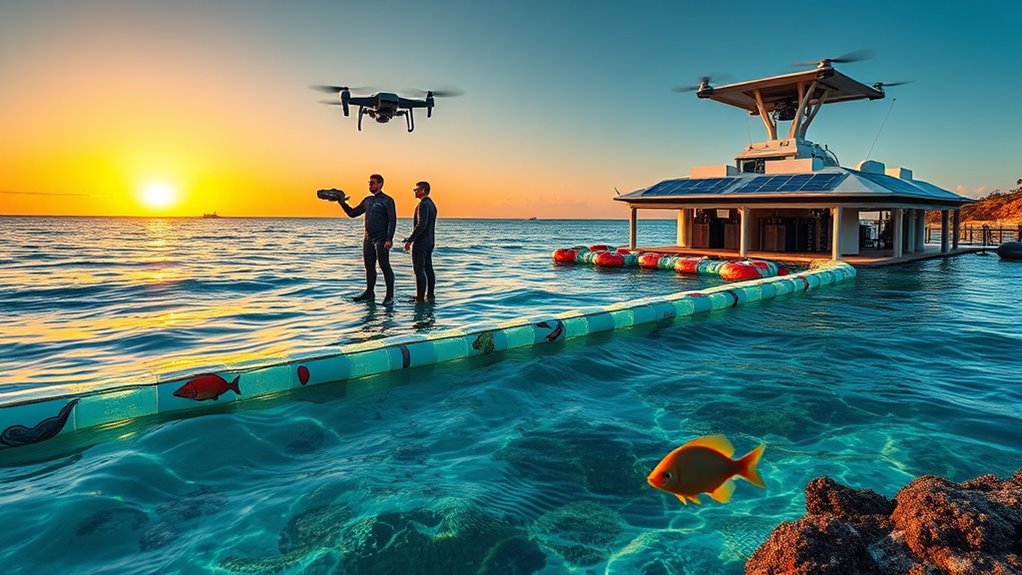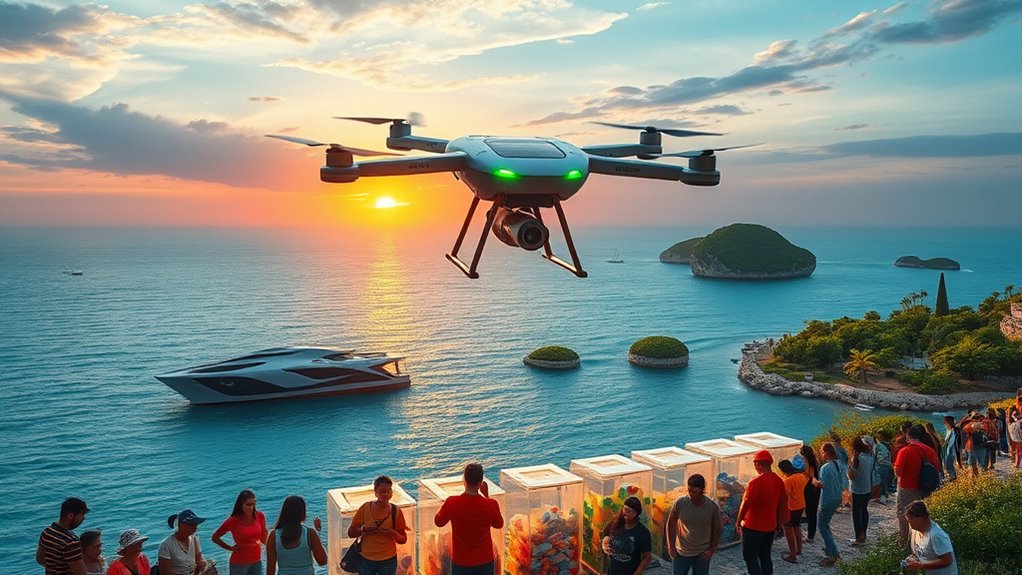In 2025, innovations in biodegradable packaging are helping you reduce plastic waste by replacing traditional plastics with eco-friendly materials that naturally break down. Advanced ocean cleanup technologies, like floating barriers and specialized filtration systems, are actively removing debris from waterways and preventing microplastics from reaching marine life. Supporting these efforts through awareness campaigns and sustainable choices amplifies impact. To see how you can be part of these solutions, explore the exciting developments shaping a cleaner future.
Key Takeaways
- Advancements in biodegradable packaging materials to replace traditional plastics and minimize environmental impact by 2025.
- Deployment of innovative ocean cleanup technologies, including floating barriers and microplastic filtration systems.
- Development of enhanced filtration and capture tools to prevent microplastics from reaching marine environments.
- Increased promotion of sustainable practices, such as supporting eco-friendly brands and reducing single-use plastics.
- Expansion of awareness campaigns and community-led initiatives to boost collective action against plastic pollution.

Plastic pollution has become one of the most pressing environmental challenges today, but there are practical solutions you can support and adopt. One of the most promising developments is the widespread use of biodegradable packaging. Unlike traditional plastics that linger in the environment for hundreds of years, biodegradable options break down naturally within a reasonable timeframe, reducing the amount of waste that ends up in landfills and oceans. By choosing products wrapped in biodegradable materials, you contribute to a significant decrease in plastic accumulation. Many companies are now innovating with plant-based plastics or other eco-friendly substances that decompose without leaving harmful residues. Supporting brands that prioritize biodegradable packaging not only helps lessen your ecological footprint but also encourages manufacturers to shift toward sustainable materials.
In addition to consumer choices, participating in or advocating for ocean cleanup initiatives plays a vital role in fighting plastic pollution. These efforts focus on removing existing plastic debris from our oceans and waterways, preventing it from harming marine life and entering the food chain. You can get involved by volunteering for local cleanup events, donating to organizations dedicated to ocean conservation, or spreading awareness about the importance of removing plastics from aquatic environments. Many initiatives deploy specialized equipment and innovative techniques to efficiently extract plastic waste from large bodies of water, often involving community participation to maximize impact. Your involvement in supporting such initiatives amplifies the collective effort needed to restore healthier ocean ecosystems. Incorporating advanced filtration systems can help further reduce microplastics that escape traditional cleanup methods.
Furthermore, technological innovations are making a difference. Researchers are developing advanced filtration systems that capture microplastics before they reach the open ocean, and some startups are creating floating barriers that trap plastic debris in high-concentration areas. These solutions are often complemented by public awareness campaigns, emphasizing the importance of reducing plastic use at the source. Educating yourself and others about proper waste disposal, recycling, and reducing single-use plastics can make a tangible difference. When you integrate eco-friendly packaging choices into your daily life and support ocean cleanup initiatives, you become part of the solution to this global crisis.
Frequently Asked Questions
How Will These Innovations Be Funded and Scaled Globally?
You’ll see global funding come from governments, private investors, and international organizations committed to sustainability. Scaling strategies include public-private partnerships, innovative business models, and technology sharing across borders. By leveraging these sources and strategies, you can help guarantee these innovations reach a worldwide impact, reducing plastic waste effectively. Your support and advocacy can also encourage more investment and collaboration, accelerating the global rollout of these essential solutions.
What Are Potential Environmental Risks of New Plastic Alternatives?
You might think new plastic alternatives are completely eco-friendly, but beware of environmental toxicity and biodegradation challenges. These innovations could unintentionally harm wildlife or persist in ecosystems longer than expected. While they’re designed to reduce waste, some may release toxic substances during breakdown or resist biodegradation, creating persistent pollution. So, as you embrace these solutions, remember that not all that glitters is green—it could still pose environmental risks.
How Will Policies Support the Adoption of These Innovations?
Policies will support your adoption of plastic innovations through strong policy incentives and clear regulatory frameworks. Governments can offer tax breaks or grants to encourage businesses to switch to eco-friendly materials. Updated regulations will set standards that promote sustainable alternatives, making it easier for you to comply and innovate responsibly. By aligning policies with environmental goals, you’ll find it easier to integrate these innovations into your practices and reduce plastic waste effectively.
What Role Do Consumers Play in Reducing Plastic Waste?
Like a gardener tending delicate plants, you play a essential role in reducing plastic waste. Your actions drive consumer education and foster behavioral change, making a real difference. By choosing sustainable products, avoiding single-use plastics, and supporting eco-friendly companies, you help create a ripple effect. Your conscious decisions encourage others to follow suit, amplifying the impact and helping to build a future where plastic pollution is considerably reduced.
How Can Developing Countries Access These New Technologies?
You can help developing countries access new technologies through effective technology transfer programs, which facilitate sharing innovations. Supporting initiatives that build local capacity is vital, enabling communities to adapt and maintain these solutions. By advocating for partnerships between governments, businesses, and NGOs, you promote equitable access. This approach guarantees developing countries can implement cutting-edge waste management technologies, reducing plastic pollution and fostering sustainable growth.
Conclusion
As you look ahead to 2025, the innovations in plastic pollution solutions promise a future you won’t want to miss. New technologies and bold ideas are emerging that could completely transform how we manage waste. But the real question is—will these breakthroughs be enough to turn the tide? The countdown has begun, and your role in this fight has never been more vital. Stay tuned—what’s coming could change everything, and you’ll want to be part of it.










